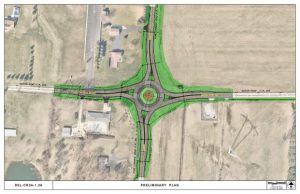Project Summary
This project is intended to upgrade the intrsection of Rome Corners and Dustin Road for safe and efficient movement of people in Berkshire Township and surrounding areas.
The County Engineer’s Office will be developing construction plans for a single-lane modern roundabout at the intersection, including storm sewers and drainage improvements for the vicinity of the intersection. A preliminary plan of the proposed design is shown here:
Why are We Doing This Project?
Delaware County is working to take proactive measures to address safety at intersections in the area. With desirable schools, amenities and natural resources, Berkshire Township is experiencing rapid growth with the sale of vacant land for development, and this is expected to continue for the next several decades.
While 2-way and 4-way stops work well at most locations, certain stop-controlled intersections have more crashes than normal. Traffic control on Ohio roads is governed by the Ohio Manual of Uniform Traffic Control Devices. The Manual provides consistency for traffic control throughout the state, and is consistent with the federal Manual on Uniform Traffic Control Devices, with the goal of promoting uniformity and ensuring that drivers know what type of traffic control to expect, even if you aren’t familiar with the area.
Many intersections have enough traffic to meet the minimum traffic volumes for 4-way stops, but this is not the case for Rome Corners and Dustin Road, as both roads are still low to moderate traffic routes. In addition, while 4-way stops may be perceived as the cure to traffic crashes, they are not a silver bullet. Other crashes can increase as a result of changing a 2-way stop to a 4-way stop such as severe rear end crashes. In the end, driver compliance with stop signs is essential to safety.
This leads to the consideration of roundabouts. Numerous studies over the last 15 years which have analyzed “before and after” traffic crash data at single lane roundabouts shows overwhelming evidence that these intersections are much safer than stop-controlled intersections. This is because of the lower speeds and the reduction of potential conflict points. It’s simple math. There are 8 conflict points at a single lane roundabout where vehicles can collide. At a normal 4-way intersection, there are 32 potential conflict points. Also, speeds are significantly lower at roundbouts, so the few crashes that may occur tend to be fender benders only.
The current and projected traffic volumes at this intersection are an excellent fit for a single-lane roundabout. Projected traffic for the next 20 years will be able to pass through this roundabout with minimal delay and at the highest level of safety for any intersection type.
What to Expect?
Once we have a more exact location for the construction limits, we will meet individually with affected property owners and offer to purchase right of way to accomodate the new roundabout. No impacts to homes or any structures are expected with this project.
Existing overhead poles and wires, and underground cables and pipelines will be relocated before or at the start of the road construction phase. Construction on single lane roundabouts generally takes around 3 months to complete and involves a full closure of the intersection for about 6 weeks. Traffic would be maintained to all properties within the work zone during construction, but through traffic will be detoured to nearby routes.
The completed roundabout would have a similar look and feel to other roundabouts in the area, such as Cheshire Road at Old State Road, or Cheshire Road at Piatt Road. The project woudl include street lighting on the approaches and landscaping in the center island. While roundabouts aren’t built to encourage truck traffic, they do accomodate trucks of all sizes with the use of a concrete apron in the center of the roundabout that longer trucks can drive over when needed.
Schedule
Engineering: 2023-24
Property Purchase: 2024-25
Utility relocation: 2025
Construction: 2025-26
Public Comments
We welcome public input including questions or comments about this project. Please address your comments or questions to the project manager:
Robert Riley, Chief Deputy Engineer (rriley@co.delaware.oh.us)

